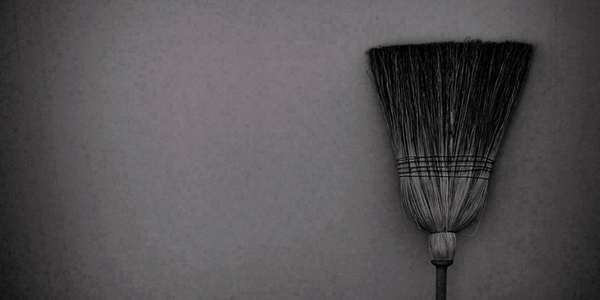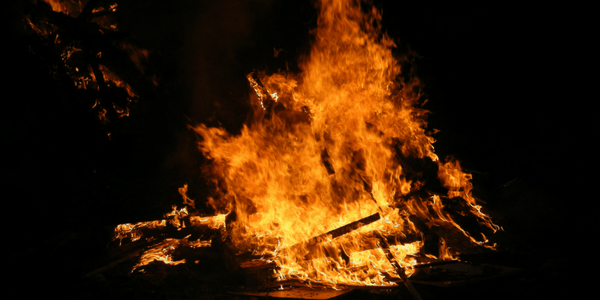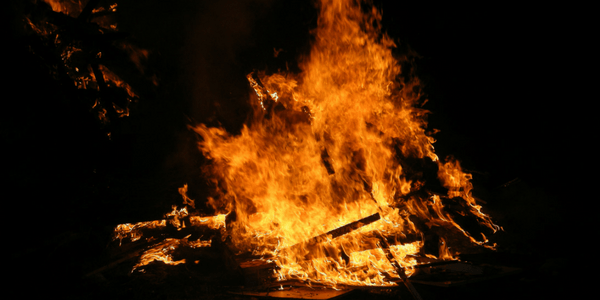 A lot of knowledge has been lost because people who were identified as witches have been murdered or otherwise silenced throughout the ages by people who feared them. Witch hunts and witch trials are a real part of the historical record, but is invoking them in today’s, modern magical communities helpful? Or is it just one more subtle divider between white people and people of colour who practice the craft? The idea of using this history to build a pillar of the magical identity should be examined.
A lot of knowledge has been lost because people who were identified as witches have been murdered or otherwise silenced throughout the ages by people who feared them. Witch hunts and witch trials are a real part of the historical record, but is invoking them in today’s, modern magical communities helpful? Or is it just one more subtle divider between white people and people of colour who practice the craft? The idea of using this history to build a pillar of the magical identity should be examined.
Before we dive deeply into this piece, I want to take a moment here to be clear that I will be discussing race, I will be discussing how the witch trials fit into the larger cultural space that is modern witchcraft. Some of what I have to say might upset you, dear reader. It’s ok.
Before commenting, I ask that you sit with your anger and discomfort. I ask that you spend the time unpacking why what I have said may seem offensive to you. I also ask that you take the time to read the full piece before you comment. You may find that, perhaps, your initial anger is a knee-jerk reaction.
When we speak of witch hunts, trials, or what is sometimes called the “Burning Times” by certain authors with a flair for the dramatic, we are referencing the witch trials that happened in Europe and America, specifically. The discussion is centred around the oppression of women but, in this case, it almost always focused on the oppression of white women.
This is especially troubling when we dealing with groups that include people of colour and men. Their magical roots may come from a different history, where they were treated in a manner very different from that sort oppression.

The trials were real
First and foremost, the witch trials were very real. European witch trials took place throughout much of the middle ages and into the 18th century, off and on, as religious political agendas changed.1 In the United States, the Salem Witch Trials took place in 1692.2
Aside from the belief that witches were in league with Satan and causing prized cows to die or milk to go sour, many of the murders and imprisonment of the victims of these trials were politically motivated or carried out due to sheer ignorance to causes of illness and natural disaster.3 They didn’t just target women, many men, especially in Europe, were accused of witchcraft as well. Women who owned land or had any sort of power were also targeted. This, for many, meant healers and the like were caught in this violence, which in turn created a break in the line of knowledge.
For as much as the witch hunts had to do with religious belief, they were also a convenient way for people to rid themselves of those they disagreed with, or to gain power by taking resources from the accused. The witch hunts and trials were not strictly religious events: they were very political in nature.
Today there are witch hunts in many modern cultures outside of the Europe and the Untied States,4 which were not a documented feature in many cultures prior to the more modern era. Although “witches” as a catch-all term for people who work with “magick” have been murdered for their practices, the trials as we have seen in Europe and the United States simply have not been the case. This in some ways indicates a cultural shift perhaps brought on by a number of features, one of which is the encroachment of western values into other cultures.
That is a larger discussion for another article. For now, the important factors are that historically, large-scale witch hunts were a product of the west, specifically, Europe and the United States, and even though the horror of them is very real, as well as the damage they caused to certain lineages, it is not a cultural event that is echoed through every magical line around the world.
This aspect is important to recognize, as it separates that particular lineage or heritage from others.

Histories that didn’t burn
Many cultures have some form of what we would consider to be “witchcraft.” The word “witch” may not be used as freely, but healers, shamans, soothsayers, and fortune tellers can all, for better or worse, be filed under the catch-all term of “witch” in many ways.
Although we may see them the same, they are not the same.
The places that these men and women occupied in their communities and how their communities interacted with them are different, historically, than those of in medieval and early modern Europe and the United States. They were considered important parts of the community for their knowledge of healing and the religious practices. They were honoured and respected.
This isn’t to say that these people never had any sort of violence against them. They could be punished for transgressions or changing religious views just as much as any other group; however, the organized hunt and murder of them is not a recorded event.
This doesn’t mean that outside of the west, all other magick traditions were allowed to exists happily, unbroken for time immemorial. When dealing with magical traditions from groups that have survived colonialism,5 their oppression looked much different, and existed for different reasons. Their knowledge was lost through broken lines and suppression as well, but it wasn’t because they were powerful with it.
When you look at a practice like Haitian Vodou, for example, it is practiced by a people who have faced very real oppression, but their magical practice and the reclamation of it is part of a full scale reclamation of a culture that was denied due to chattel slavery. The same can be said of hoodoo or Santeria. The religion or practice leads back to folklore and history that is hidden within it, it’s not just the magick, but an entire culture that is being called back and given new life, despite the focus on destroying it.
The same can be said of many Indigenous groups who are supporting, vocally, their own cultural beliefs as well as groups in South America, Indigenous people in Australia, and the list goes on and on.
It was because they were being oppressed under colonial rule, which sought to strip people of their heritage in order to make them more compliant servants. Religious traditions were banned, the language of people was forbidden, and their art and culture were ripped away.
This process was one that is happening against an entire people, not just a handful of targets, and it affects an entire group, not just a few along the line. Whole cultures are lost to the violence of colonialism, and it is more than just magick that they work to regain.
Related: Problems with whitewashing in worship, by Donyae Coles
Related: Worshipping familiar gods: Going beyond pop culture, by Donyae Coles

The problem with “we all burned”
The issue here is that the European and American witch trials and witch hunts are being touted as if it were a part of the history and culture of all witches, which it was not. The “Burning Times” is one of many narratives, and as a narrative it is restrictive. The narrative of the burning witches is that we’re reclaiming a specific sort of history and knowledge that was lost during that time.
Although specific knowledge was lost due to the ignorance and violence of men, the culture and history of the people who were persecuted during that time survived. We know some of their names, their families. We still have much of their knowledge that can be found through study. The culture they existed within — European and American culture — continued to exist after their deaths. No one who descended from these people today are oppressed for their practices. No one is still affected, in a physical sense, by that loss.
On the other side of that, for people who come from other magical traditions where witch hunts were not a thing, they are attempting to reclaim whole cultures and histories that have been lost and suppressed, piecing together what bits of information is left to form a whole picture.
As mentioned above, many of these traditions that come from oppressed people are still in use and continuously evolving to meet the demands of the modern world. We see changes in how things like Santeria or hoodoo is practiced that reflect the ways that the people who engage with these old beliefs live their modern lives.
The narrative of the witch hunts and trials of Europe and the United States being a cultural event shared by all overlooks the fact that, for many people coming into this path, the things they lost and are healing from after generations are more than just the loss of magick: this is tied into their loss of heritage as well. It is simply not a shared story, and in proclaiming it as one, it overwrites the varied practices that people come form in order to make them something more homogeneous and, well, white.
Related: Black witch resources: Getting started, by Donyae Coles
Related: Black witch blues: The whiteness of magick spaces, by Donyae Coles

Witch trials as false oppression
As we’ve already started in this piece, the trials and hunts were real. Real people were tortured and murdered. We are not disputing this. However, the framing of these historical events is questionable. In today’s Pagan culture, these events are often used to frame witches as oppressed when they are, for the most part, anything but.
For sure, there are many people who must keep their practice a secret, we’ve discussed this in a past article, but no one is oppressed due to their practice of witchcraft. But the mention and use of these events is meant to create the feeling that by taking up these practices, we are overcoming and reclaiming an ancestral right.6
This is even more problematic when you begin to dissect the history around such trials. Although there were women (and men) who practiced some form of “Pagan” worship that were killed during the trials, the vast majority of people were innocent victims, some of whom had herbal knowledge, but many who did not.
Which is to say that this narrative of women who were murdered for their control of magick is a fantasy. But who’s fantasy is it?
The answer is that it is a fantasy for white people to feel connected to something that was powerful and overcoming the violence of the time to reclaim that power makes people feel powerful. There’s nothing essentially wrong with this, but we need to recognize that it is a narrative that is based in whiteness.
I am well aware of Tituba7 and her place in these stories; however, she is rarely spoken of, perhaps because she was not killed, but more likely because she was Black. The image that the Salem Witch Trials conjures does not include her. Nor are there any faces of colour in the images that we dream up for the European hunts either, although they no doubt included people of colour. These people have been erased.
Because the fantasy is based in a very specific culture, it excludes people who don’t come from that culture. And if we’re using it as leg to build the community on, this shared pain, then the people who do not share it because their people never lived it, cannot be an authentic part of it.

The Burning Times narrative fails some witches
Throughout the middle ages and into the 18th century, people were tortured and killed by a patriarchal and violent system for a number of religious and political reasons. This is the truth. It is horrible and painful. Remembering those people who were murdered for the greed and ignorance of others is important and learning from their stories can give you power and comfort.
But these are not everyone’s stories.
Although they can be told and shared widely so that they are never forgotten, turning them into the one of the base beliefs of modern witch culture is harmful and excludes the many, many people that have no connection with that history.
Creating folklore is an important part of being human, it fosters community and connection. High John the Conqueror is a folktale created by enslaved Africans to give them hope, and through his stories and the roots and oils that carry his name, modern rootworkers still find power. Similarly, the idea that a mythical woman who was burned during the witch hunts for her power and knowledge may give others strength.
But there is a responsibility in creation that must be addressed. Asking questions: Why does this story need exist? What purpose will she serve in our greater unconsciousness and can she help heal everyone who she is meant to help? If the answer is no, can we expand her story? Can we make it one that meets the needs of the community we want to build? These are issues that those invoking this story must consider.
Find strength where you can, but when creating community, ensure that it is a narrative that everyone in the community can connect with.
Image credits: Daniel Horacio Agostini, Tim Difford, Carsten ten Brink, Angelina Earley, and Keith Avery
- Jone Johnson Lewis, “Witch Hunts: Timeline of the European History and Its Roots,” Thoughtco, 2017. [↩]
- “Salem Witch Hunt Begins,” History.com, accessed 3 February 2018. [↩]
- Brian A. Pavlac, “Theories of Origins About Witch Hunts,” King’s College, 2006. [↩]
- Mitch Horowitz, “The Persecution of Witches, 21st-Century Style,” New York Times, 5 July 2014. [↩]
- “Colonialism,” Stanford Encyclopedia of Philosophy. [↩]
- See Psyche’s articles, “The Broom Closet: In or Out?,” and “Stepping out of the broom closet: Coming out as Wiccan or Pagan,” and Donyae Coles’ article, “Secret witch: Magick when you’re stuck in the broom closet.” [↩]
- Stacy Schieff, “Unraveling The Many Mysteries Of Tituba, The Star Witness Of The Salem Witch Trials,” Smithsonian, 2015. [↩]








